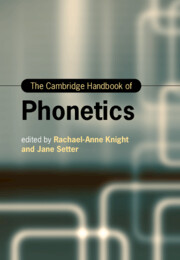Book contents
- The Cambridge Handbook of Phonetics
- Cambridge Handbooks in Language and Linguistics
- The Cambridge Handbook of Phonetics
- Copyright page
- Contents
- Figures
- Tables
- Contributors
- Introduction
- Section I Segmental Production
- Section II Prosodic Production
- Section III Measuring Speech
- 10 Measuring Vowels
- 11 Measuring Consonants
- 12 Measuring Speech Rhythm
- 13 Fundamental Frequency and Pitch
- 14 Observing and Measuring Speech Articulation
- 15 Beyond Functional Speech Synthesis
- Section IV Audition and Perception
- Section V Applications of Phonetics
- Index
- References
13 - Fundamental Frequency and Pitch
from Section III - Measuring Speech
Published online by Cambridge University Press: 11 November 2021
- The Cambridge Handbook of Phonetics
- Cambridge Handbooks in Language and Linguistics
- The Cambridge Handbook of Phonetics
- Copyright page
- Contents
- Figures
- Tables
- Contributors
- Introduction
- Section I Segmental Production
- Section II Prosodic Production
- Section III Measuring Speech
- 10 Measuring Vowels
- 11 Measuring Consonants
- 12 Measuring Speech Rhythm
- 13 Fundamental Frequency and Pitch
- 14 Observing and Measuring Speech Articulation
- 15 Beyond Functional Speech Synthesis
- Section IV Audition and Perception
- Section V Applications of Phonetics
- Index
- References
Summary
Pitch, the subjective impression of whether individual speech sounds are perceived as relatively high or low, is an important characteristic of spoken language, contributing in some languages to the lexical identity of words and in all languages to the perception of the intonation pattern of utterances. Pitch corresponds to the physiological parameter of the frequency of vibration of the vocal folds, the fundamental frequency, which can be measured in cycles per second or hertz.Estimating and measuring fundamental frequency and modelling pitch is not easy. After presenting some automatic models of pitch, we address issues related to the detection and measurement of fundamental frequency, including tracking/detection errors, and explain how many of these errors can be avoided by the appropriate choice of pitch ceiling and floor settings. We finally discuss the use of acoustic scales (linear, logarithmic, psychoacoustic) for the measurement of pitch. Based on evidence from recent findings in neuroanatomy, neurophysiology, behavioural studies and speech production, we suggest that a new scale, the Octave-Median (OMe) scale, appears to be more natural for the study of speech prosody.
Keywords
- Type
- Chapter
- Information
- The Cambridge Handbook of Phonetics , pp. 336 - 361Publisher: Cambridge University PressPrint publication year: 2021
References
13.7 References
- 6
- Cited by



